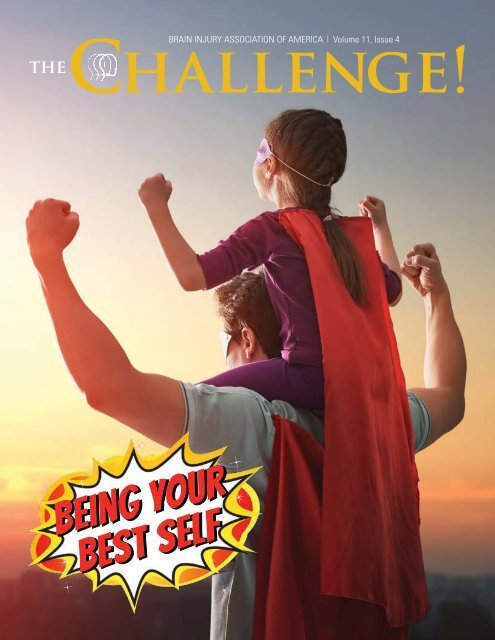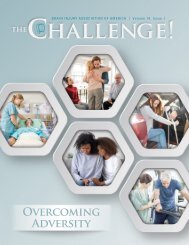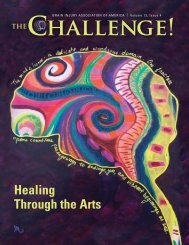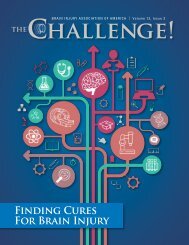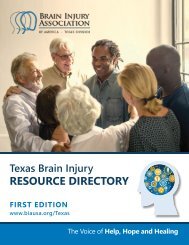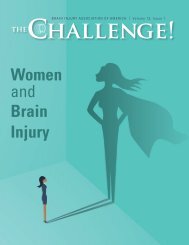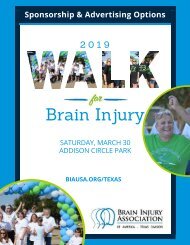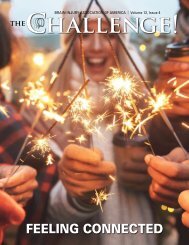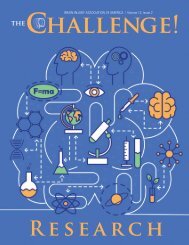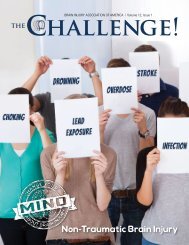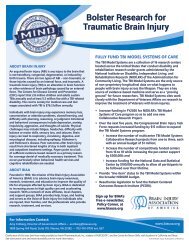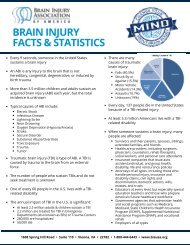Being Your Best Self
Fall 2017
Fall 2017
You also want an ePaper? Increase the reach of your titles
YUMPU automatically turns print PDFs into web optimized ePapers that Google loves.
BRAIN INJURY ASSOCIATION OF AMERICA | Volume 11, Issue 4<br />
Challenge!<br />
the<br />
<strong>Being</strong> <strong>Your</strong><br />
<strong>Best</strong> <strong>Self</strong>
Table of CONTENTS<br />
FALL 2017<br />
THE Challenge! is published<br />
by the Brain Injury Association<br />
of America. We welcome<br />
manuscripts on issues that are<br />
important to the brain injury<br />
community. Please send<br />
submissions in a standard<br />
Microsoft Word ® document to<br />
publications@biausa.org.<br />
4› Returning to Work<br />
After Brain Injury<br />
8› Hart and Weintraub<br />
Named as BIAA Award<br />
Recipients Award Winners<br />
Recognized for Contributions<br />
to Research and Clinical Care<br />
4<br />
For more information regarding<br />
advertising in THE Challenge!,<br />
please visit www.biausa.org.<br />
Association Staff & Volunteers:<br />
Marianna Abashian<br />
Greg Ayotte<br />
11› Goal Setting<br />
14› “The Concussion Girl”<br />
16› Honor Roll of Donors<br />
11<br />
Christine Chen<br />
Stephanie Cohen<br />
Amy C. Colberg<br />
Susan H. Connors<br />
William Dane<br />
Sarah Drummond<br />
Tiffany Epley<br />
Dianna Fahel<br />
Holly Kisly<br />
Jessica Lucas<br />
18› <strong>Being</strong> a Bumble Bee<br />
20› Advocacy Update<br />
23› State Affiliate News<br />
27› Brain Injury Advisory<br />
Council Corner<br />
Member Spotlight:<br />
Stephanie Freeman<br />
Specific<br />
Measurable<br />
Achievable<br />
Relevant<br />
14<br />
Time-bound<br />
Jennifer Mandlebaum<br />
Carrie Mosher<br />
29› The BIAA Bookshelf<br />
Jordan Ortiz<br />
Mary S. Reitter<br />
Postmaster:<br />
Send address changes to:<br />
THE Challenge!<br />
1608 Spring Hill Rd., Suite 110<br />
Vienna, VA 22182<br />
Copyright 2017 BIAA<br />
All rights reserved.<br />
No part of this publication may<br />
be reproduced in whole or in<br />
part without written permission<br />
from the Brain Injury Association<br />
of America. Email requests to<br />
publications@biausa.org.<br />
30› News and Notes<br />
30› Upcoming Webinars<br />
26<br />
20<br />
Publication designed by<br />
Eye to Eye Design Studio, LLC<br />
www.eyetoeyedesignstudio.net<br />
Please recycle this issue.<br />
2
From my DESK<br />
Thank you to the many readers who expressed appreciation for<br />
the summer issue of THE Challenge!, focused on research. The<br />
Brain Injury Association of America (BIAA) is always pleased<br />
to highlight the work of government agencies, hospitals,<br />
universities, and other institutions in our shared goal to<br />
advance brain injury research. Recently, we teamed up with<br />
SanBio to help recruit participants for a clinical trial called<br />
STEMTRA (Study of Modified Stem Cells in Traumatic Brain<br />
Injury). To learn more, visit https://tbiresearchstudy.org.<br />
I send a great big<br />
shout out to the many<br />
generous contributors<br />
who donated their<br />
precious time and<br />
money to BIAA<br />
throughout 2017 –<br />
we would be lost<br />
without you.<br />
Thank you to the volunteer leaders and paid staff professionals<br />
from BIAA affiliates across the country who gathered for the<br />
22nd Annual Leadership Conference, Nov. 8-10, in sunny<br />
Florida. In addition to the training and networking that occurs<br />
throughout the meeting, BIAA also takes this opportunity to<br />
recognize affiliates that deliver exceptional programs and<br />
services. This year’s Award of Excellence winners are: the<br />
Brain Injury Associations of Georgia, Kansas and Greater<br />
Kansas City, Louisiana, Maryland, Massachusetts, Michigan,<br />
New Hampshire, and New York State. BIA of Missouri’s<br />
chief volunteer leader, David Dyck, Jr., DO, and chief staff<br />
professional, Maureen Cunningham, CFRE, were also honored.<br />
November is National Family Caregivers Month. THE Challenge!<br />
readers will want to take a moment to acknowledge how<br />
important caregivers are in helping individuals who have been<br />
injured regain the maximum level of independence possible. If<br />
there is a special caregiver in your life, please say thank you!<br />
#GivingTuesday also takes place in November, and SanBio<br />
has agreed to be our sponsor for the online event. They'll<br />
be matching gifts up to $2,100, so please consider making<br />
a donation on that day. For more information about<br />
#GivingTuesday, follow us on Facebook, Twitter, and Instagram.<br />
And finally, I send a great big shout out to the many generous<br />
contributors who donated their precious time and money to<br />
BIAA throughout 2017 – we would be lost without you.<br />
The brain injury community has BIAA’s best wishes for a happy<br />
and safe holiday season.<br />
Susan H. Connors, President/CEO<br />
Brain Injury Association of America<br />
www.biausa.org 3
RETURNING<br />
TO WORK<br />
AFTER BRAIN<br />
INJURY<br />
By Margaret Koch, Director of Vocational Services, Hope Network Neuro Rehabilitation<br />
Work is such an important part of our lives —<br />
it gives us meaning and purpose. Having<br />
a job that we do well allows us to feel<br />
competent and successful. Work is a good place to<br />
meet people and make friends. Earning a paycheck<br />
also helps us meet our needs and support our families.<br />
But a brain injury can throw a big wrench into the<br />
picture. You may experience challenges with memory<br />
and attention, making it hard to manage the various<br />
stimuli in the environment. You might have physical<br />
challenges and your social skills may be affected.<br />
Things that used to be easy may now be more difficult.<br />
You might wonder what’s to come or have other<br />
questions and concerns. For example, you may ask:<br />
Will I be able to do the things I did before my injury?<br />
Will I be able to go back to work? Will I need to find<br />
a different job? Who will help me with my return to<br />
work journey?<br />
No wonder it can be difficult to figure out how to<br />
get back to work! Fortunately, there are resources to<br />
point you in the right direction and help you meet<br />
your goals of returning to work after a brain injury,<br />
whether that means building skills, returning to a<br />
previous job, or finding a new job.<br />
4
ELEMENTS OF A RETURN TO WORK PLAN:<br />
Vocational Rehabilitation:<br />
Where to Begin?<br />
Vocational rehabilitation (VR) programs can be<br />
helpful to you and your family as you begin the<br />
process of returning to the workforce. These<br />
programs can help you determine where you are,<br />
where you want to go, and how to get there. This<br />
might include services such as:<br />
• Vocational evaluations<br />
• Situational assessments<br />
• Work adjustment services<br />
• Interest testing<br />
• Vocational counseling<br />
• Job analysis<br />
• Identifying job accommodations<br />
VR programs help you get back to work. If you were<br />
working before your injury, it is best to start thinking<br />
about VR sooner rather than later. As you consider<br />
your options, it is also helpful to talk to your social<br />
worker, case manager, and doctor about returning to<br />
work. Here are some other tips to get you started:<br />
KNOW YOUR RIGHTS<br />
The Americans with Disabilities Act (ADA) was<br />
signed into law to make American society accessible<br />
to everyone, including people with brain injuries.<br />
Title I of the ADA deals with employment and<br />
requires companies with 15 or more employees to<br />
provide reasonable accommodations to applicants<br />
and employees with disabilities. The law also<br />
prohibits discrimination on the basis of disability<br />
in all aspects of employment. For more information<br />
about the ADA and reasonable accommodations,<br />
visit the Job Accommodation Network website:<br />
http://Ask.JAN.org/links/adalinks.htm#1 or visit<br />
https://www.dol.gov/general/topic/disability/ada.<br />
(continued on page 6)<br />
www.biausa.org 5
(continued from page 5)<br />
CONTACT HUMAN RESOURCES<br />
The human resources department at your<br />
employer will be able to help you determine if you<br />
qualify for any benefits, such as short- or longterm<br />
disability insurance. If you have worked for<br />
your employer for at least one year, you may also<br />
qualify for the Family Medical Leave Act (FMLA),<br />
which protects your job for up to 12 weeks while<br />
you are recovering. FMLA may also be available<br />
to your family members if they need to take a<br />
leave of absence to care for you. When you are<br />
ready to return to work, you should talk to your<br />
employer about allowing you to come back with<br />
accommodations to help you with your transition.<br />
How to Pay for<br />
Vocational Rehabilitation<br />
Unfortunately, private health insurance benefits<br />
do not cover vocational rehabilitation; however,<br />
there are other options available.<br />
1<br />
2<br />
3<br />
If you were injured at work, you are<br />
entitled to Workers’ Compensation<br />
insurance, which provides wage<br />
replacement and medical benefits<br />
(benefits vary from state to state).<br />
If you were injured in a motor-vehicle<br />
accident, you may be entitled to medical<br />
and rehabilitation benefits through your<br />
automobile insurance. Some states have<br />
Auto No-Fault Insurance for treatment<br />
that is reasonable and necessary,<br />
including brain injury rehabilitation.<br />
For more information, contact your<br />
insurance company.<br />
If neither of those options are available<br />
to you, contact the VR agency in your<br />
state. These programs provide vocational<br />
and rehabilitative services to individuals<br />
with disabilities to help them prepare for,<br />
obtain, regain, or maintain employment.<br />
To find the VR agency in your state, visit:<br />
http://www.askearn.org/state-vocationalrehabilitation-agencies/.<br />
6
What if I’m not ready to<br />
go back to work right now?<br />
Even if you aren’t ready to go back to work yet, you can<br />
take other steps to become prepared. First, contact your<br />
human resources department to find out your benefit<br />
status. Next, make sure that your family, employer,<br />
doctor, and rehabilitation team know that you want to<br />
go back to work. Participate in vocational assessment<br />
and counseling and in vocational rehabilitation to<br />
identify your current strengths and challenges.<br />
Going back to work, whether it’s the job you did<br />
before or a different one that matches your new<br />
strengths, is a major goal for many people with brain<br />
injury. Thinking about returning to employment early<br />
on can help you and your family develop a plan that<br />
will help you to be successful.<br />
Margaret Koch, B.A., is a Certified Brain Injury Specialist (CBIS) with more<br />
than 35 years of vocational rehabilitation experience. She has been the<br />
leader of the Grand Rapids Chapter of the BIA of Michigan for more than<br />
20 years. Margaret can be reached at 616-940-0040, ext. 18270 or by email<br />
at mkoch@hopenetwork.org.<br />
Look out for BIAA’s<br />
New Website in 2018!<br />
www.biausa.org 7
HART AND WEINTRAUB<br />
Named as BIAA Award Recipients<br />
AWARD WINNERS RECOGNIZED FOR<br />
CONTRIBUTIONS TO RESEARCH AND CLINICAL CARE<br />
Each year, the Brain Injury Association of America (BIAA) presents the William Fields Caveness Award in<br />
recognition of an individual who, through research on both a national and international level, has made<br />
outstanding contributions to bettering the lives of individuals with brain injury.<br />
Tessa Hart, Ph.D., is the recipient of the 2017 William Fields Caveness Award.<br />
Tessa Hart, Ph.D., is institute scientist at the Moss Rehabilitation<br />
Research Institute in Elkins Park, Pennsylvania, where<br />
she directs the Traumatic Brain Injury (TBI) Clinical<br />
Research Laboratory and the Moss TBI Model<br />
System. She is also research professor in the<br />
department of rehabilitation medicine at Sidney<br />
Kimmel Medical College, Thomas Jefferson<br />
University, Philadelphia. Dr. Hart’s wide-ranging<br />
research interests include creating and testing<br />
treatments to improve executive function,<br />
emotional function, and self-regulation. Her other<br />
interests include vocational rehabilitation for<br />
TBI and the use of assistive technology for<br />
cognition. Dr. Hart further advances the field<br />
of brain injury rehabilitation by serving<br />
on multiple peer review panels, editorial<br />
boards, and national and international<br />
task forces.<br />
8
The Sheldon Berrol M.D. Clinical Service Award is presented annually to an individual who, through a long<br />
service career, has made outstanding contributions to improving the quality of care, professional training,<br />
and/or education in the field of brain injury.<br />
Alan Weintraub, M.D., is the Sheldon Berrol M.D. Clinical Service Award winner.<br />
Alan Weintraub, M.D., has been medical director of the<br />
brain injury program at Craig Hospital since 1986.<br />
Dr. Weintraub has also served as medical director<br />
of post-acute residential brain injury programs<br />
and several long-term subacute brain injury<br />
programs. He is an associate clinical professor<br />
at the University of Colorado Health Sciences<br />
Center and an active consultant to the Colorado<br />
Division of Workers’ Compensation Medical<br />
Treatment Guidelines TBI Task Force. As a Brain<br />
Injury Medicine Certified Subspecialist, Dr. Weintraub<br />
has special interests in predictive biomarkers for<br />
recovery, neuroimaging, pharmacological rehabilitation<br />
management, sports-related concussion, and the<br />
long-term consequences of brain injury. He<br />
is actively involved in local, regional, and<br />
national organizations and is devoted<br />
to addressing the aging and long-term<br />
needs of persons with brain injury and<br />
their families. For more than 30 years, Dr.<br />
Weintraub has lectured extensively to<br />
broad audiences and written on a number<br />
of specific topics related to both traumatic<br />
and acquired brain injury.<br />
The awards were presented at the conference of the American Congress of Rehabilitative Medication (ACRM),<br />
held Oct. 23-28 in Atlanta, Georgia.<br />
www.biausa.org 9
GOAL SETTING<br />
Specific<br />
Measurable<br />
Achievable<br />
Relevant<br />
Time-bound<br />
By Celeste Campbell, Psy.D.<br />
Come with me on a trip! Ready? Let’s go!<br />
I<br />
imagine most of you are thinking, “A trip to<br />
where? How far is it? How are we getting there?<br />
Who else is going?”<br />
This is the essence of goal setting. You would not set<br />
out on a trip without a plan; getting somewhere in life<br />
also requires a plan.<br />
A well-developed goal is a map. It should clearly<br />
define where you want to go and must clearly state<br />
the steps you have to take to get there. In this highspeed<br />
world, there are many demands upon our time,<br />
our energy, and our focus. Having specific goals helps<br />
us get back on track when life throws little detours<br />
and distractions at us — and it will!<br />
Most of us have had the experience of feeling as though<br />
we have done a lot of work but have not accomplished<br />
anything. Most of the time, this is because the work<br />
was not organized or focused on a specific purpose.<br />
Setting goals helps us see whether what we are doing<br />
is getting us where we want to go. Setting goals also<br />
gives us motivation to keep moving. If it doesn’t really<br />
matter where we end up and if we have no place to go,<br />
it is hard to be motivated to move at all.<br />
SMART is an acronym developed to help us<br />
remember the elements of a strong goal. SMART<br />
reminds us that a goal must be Specific, Measurable,<br />
Achievable, Relevant, and Time-bound.<br />
Let’s look at each one of these components.<br />
A SMART goal is specific.<br />
If you say you want to travel, does traveling to the<br />
corner store count? Does it count if it is to another<br />
state? Another country? Do you want to go to a<br />
tropical place or travel to historically significant sites<br />
in Europe? If you define a specific destination, it is<br />
easy to tell when the goal has been achieved. <strong>Your</strong><br />
brain focuses on the information you feed it. If your<br />
goal is vague, your brain doesn’t know what to focus<br />
on. If you have defined your goal very specifically, on<br />
the other hand, your brain will focus on recognizing<br />
opportunities that will move you toward that goal.<br />
A SMART goal is measurable.<br />
How are you going to measure your goal and how<br />
will you know when you have reached it? A goal like,<br />
“I want to have more money,” is not measurable.<br />
(continued on page 12)<br />
www.biausa.org 11
(continued from page 11)<br />
If someone hands you a nickel, will you check this<br />
goal off your list? On the other hand, a goal that<br />
says, “I want to have enough money to buy a car,” is<br />
measurable. You can find out what that amount is and<br />
then figure out how much you have to set aside each<br />
week or month to achieve it by a specific date. You<br />
can even measure your progress each step of the way.<br />
A SMART goal is achievable.<br />
It is within the realm of physical possibility so long as<br />
you have sufficient time, effort, and resources. Now,<br />
I am sure there are some people who have been told<br />
that their goals are unrealistic. I would argue that<br />
there are few goals that are unrealistic if enough time,<br />
effort, and resources are devoted to them. So, while a<br />
goal such as, “I want to sprout wings and fly to Jupiter<br />
on a skateboard,” may be unrealistic, other goals such<br />
as getting a job, getting married, living on your own,<br />
or traveling may seem beyond your reach now but<br />
are certainly achievable. The questions you should<br />
ask are, “What will it take to achieve it?” and “Am I<br />
willing to do what it takes?” Many goals labeled as<br />
unrealistic are in fact achievable, but require so much<br />
time, effort, and resources that the cost far exceeds<br />
the benefit of achieving them. It is OK to change goals,<br />
especially if working on one goal means that the rest<br />
of your life will be thrown out of balance. Set your<br />
goals based on an honest assessment of what it might<br />
take to achieve them.<br />
A SMART goal is relevant (to you).<br />
Setting goals to please other people is not going<br />
to motivate or excite you. A goal is something that<br />
will make a significant change in your life for the<br />
better. While a goal like, “I will learn to balance my<br />
checkbook,” may be meaningful, a goal like, “I will<br />
save up enough money to buy a car,” might be more<br />
motivating. Learning to balance the checkbook<br />
may be important, but will it be enough to excite or<br />
motivate you?<br />
A SMART goal is time-bound.<br />
Many of us only take action when there is a sense<br />
of urgency. When you have a specific deadline for<br />
getting something done, you are more likely to get<br />
it done. Set a timeline for achieving your goal. This<br />
12
helps provide accountability and helps you measure<br />
how far along you are in achieving your goal. Setting<br />
time limits for each step helps to keep you moving<br />
at a steady pace toward it.<br />
How do you go about goal-setting?<br />
Write <strong>Your</strong> Goals Down!<br />
First, develop your ultimate “big picture” goal. Create<br />
a vision of how you want things to be. Make your goal<br />
as detailed as you can by describing who, what, when,<br />
where, and why you want to achieve this goal.<br />
Above all, remember<br />
the #1 Rule of Goal<br />
Setting: Write <strong>Your</strong><br />
Goals Down!<br />
Second, break down your ultimate goal into longterm<br />
goals. Break down your long-term goals into<br />
smaller, short-term goals, and then again until you<br />
have a series of immediate goals. An immediate goal<br />
is something you could do today. If your goal is not<br />
broken down into something you could potentially do<br />
today, break it down even further. This way, you will<br />
have a very clear next step.<br />
Ultimate Goal<br />
Long Term Goal<br />
Long Term Goal<br />
Short Term Goal<br />
Short Term Goal<br />
Short Term Goal<br />
Short Term Goal<br />
Immediate Goal<br />
Immediate Goal<br />
Immediate Goal<br />
Immediate Goal<br />
Immediate Goal<br />
Immediate Goal<br />
Immediate Goal<br />
Immediate Goal<br />
Dr. Celeste Campbell is a neuropsychologist who has been practicing for more than 25 years. She received her undergraduate degree at Yale University, holds<br />
a doctoral degree from Drexel University, and has completed a postdoctoral fellowship in rehabilitation neuropsychology at National Rehabilitation Hospital<br />
in Washington, D.C. She is licensed in Georgia and Virginia. When she is not practicing neuropsychology, Dr. Campbell might be found on the stage of a local<br />
community theater. Or she might be on a beach in Hawaii.<br />
www.biausa.org 13
“The Concussion Girl”<br />
By Audrey Taylor<br />
Soccer was (and still is) my entire life. It was<br />
where I found peace, felt challenged, met some<br />
of my closest friends, made some of my most<br />
precious memories, and even met my husband.<br />
Unfortunately, my love and dedication to the sport<br />
also came with a high price. It almost cost me my<br />
life — more than once.<br />
I started playing soccer when I was in elementary<br />
school; piano and dance classes quickly took a<br />
backseat. I played on three different travel teams and<br />
eventually on our school team. When I was 14 years<br />
old, however, things took a sudden shift. I sustained<br />
my first concussion during a travel game. I took an<br />
elbow to my right temple, but was sent back out for<br />
the second half of the game anyway. Today, we know<br />
this is a major mistake; the increased risk of getting<br />
another concussion within hours after suffering the<br />
first one is significant. I was lucky I was not injured<br />
again during that game. Little did I know, however,<br />
that my brain would never be the same from that day<br />
forward.<br />
When I made the high school varsity team during<br />
freshman year, I was over the moon. I attended as<br />
many extra training sessions as I could and began<br />
planning the steps I needed to take in order to<br />
achieve my dream of becoming a professional soccer<br />
player. Sadly, the hits to the head just kept coming.<br />
I was smacked by flailing arms, thrown onto the<br />
ground repeatedly, and pushed into goal posts. My<br />
health deteriorated, and eventually I was forced to<br />
stop playing the sport I loved so much.<br />
Sadly, the beautiful game wasn’t the only part of<br />
my life that was different. My grades suffered. I lost<br />
friends, lost my way, and ultimately felt like I had lost<br />
myself. There were constant whispers about how I<br />
was “weird,” “different,” and a “freak.” I became “the<br />
concussion girl.” Instead of finding my own way, I just<br />
followed along. Had it not been for my best friend,<br />
Rachel, and my wonderful boyfriend (and future<br />
husband), Ryan, I would have lost myself altogether.<br />
14
Once I graduated high<br />
school, I attended Auburn<br />
University. My health was<br />
worsening, but I kept my<br />
issues hidden. I put on the<br />
best face I could and tried<br />
to have a “normal” college<br />
life. In 2012, I was in a<br />
head-to-head collision that<br />
injured my neck horribly<br />
and left me with a moderate<br />
traumatic brain injury. I had<br />
to withdraw from college.<br />
Many doctors were shocked<br />
that I was still alive, let<br />
alone able to function.<br />
Behind closed doors, I was<br />
suffering from fainting<br />
spells, severe migraines,<br />
horrible cluster headaches,<br />
issues with fine motor<br />
skills, aphasia, loss of<br />
hearing, loss of vision,<br />
and extensive memory<br />
loss. Most of my childhood<br />
memories were completely gone. If I “remembered”<br />
anything from that missing period, it was only from<br />
photographs or what people would tell me about my<br />
past. There was no waking up from this nightmare.<br />
Although I was bedridden and in a very dark place,<br />
my incredible doctors worked magic and God worked<br />
miracles. I finally returned to college and thrived<br />
with help from the wonderful disability program at<br />
Auburn. My treatment was working and the medicine<br />
helped tremendously. The original dark outlook<br />
began to turn brighter and I was able to take on<br />
my Montana dream with Ryan, now my fiancé,<br />
by my side.<br />
We moved across the country so I could attend my<br />
dream college, the University of Montana. I became a<br />
member of the most prestigious honor society in the<br />
nation and graduated with high honors and a degree<br />
in graphic design. My designs and articles have been<br />
published in books, blogs, and other media outlets,<br />
and my story has appeared in various magazines.<br />
Ryan and I got married at Walt Disney World and built<br />
our dream home in the gorgeous Rocky Mountains.<br />
When people ask me<br />
how I was able to find the<br />
strength to accomplish my<br />
goals, my answer is simple:<br />
I had plenty of help. Rachel,<br />
Ryan, and my family were<br />
there with me every step<br />
of the way. They gave me<br />
shoulders to cry on and<br />
always found ways to make<br />
me laugh. I was blessed<br />
with incredible, selfless,<br />
and patient guardian angels<br />
who never gave up on me,<br />
even when I gave them so<br />
many reasons to do so. For<br />
that and so much more,<br />
I am forever indebted to<br />
them.<br />
My dance with death has<br />
been quite the adventure,<br />
but it has taught me a<br />
great deal about life. Yes,<br />
it is short. Yes, it is a gift.<br />
But most importantly, life<br />
is truly delicate. The way you choose to live greatly<br />
determines your life’s outcome. If I could share<br />
any advice with those reading this, it would be the<br />
following:<br />
Surround yourself with the ones you love and do not<br />
take anything for granted. In the blink of an eye, your<br />
moment to appreciate life and those within it could<br />
be gone. I will end with one of my favorite quotes by<br />
Rikki Rogers: “Strength doesn't come from what you<br />
can do. It comes from overcoming the things you once<br />
thought you couldn’t.”<br />
Stay strong, my friends.<br />
Audrey is a graphic designer based in the gorgeous city of Missoula,<br />
Montana. She specializes in typography, print design, branding, advertising,<br />
web design, and motion graphics. She loves finding the beauty in the<br />
ordinary and is inspired by the natural world. She also has a professional<br />
background in photography and videography. Her work has been published<br />
in various magazines, books, brochures, and multiple online media outlets<br />
(including the Fall 2013 edition of THE Challenge!) When she is not designing<br />
or spending time at Walt Disney World, you will find Audrey in the mountains<br />
with her husband, Ryan, and their two dogs, Cooper and Si.<br />
www.biausa.org 15
Honor Roll of DONORS<br />
July 1, 2017 – September 30, 2017<br />
HONORS<br />
In honor of Adam Wilk and our wedding<br />
Ms. Meredith Sargent<br />
In honor of Alexis Verzal<br />
Mr. & Mrs. Mike and Linda Verzal<br />
In honor of Allen and Ellen Rubin's<br />
50th wedding anniversary<br />
Mr. Terry Meyerson<br />
In honor of Anita Winstead<br />
Mrs. Lucy A. Scott<br />
In honor of Anthony Curtis<br />
Active Autobody Inc.<br />
In honor of Anthony Loudermilk<br />
Mr. & Mrs. Guy and Theresa Loudermilk<br />
In honor of Catherine DiGiovanni<br />
Mr. & Mrs. Phillip and Mary DiGiovanni<br />
In honor of Cedric McKinney<br />
Mrs. Joyce McKinney<br />
In honor of Dan Froehlich<br />
Mr. Dan Froehlich<br />
In honor of Darcie Lang<br />
Ms. Darcie Lang<br />
In honor of Greg Ayotte<br />
Ms. Carolyn Stringer<br />
In honor of Jennifer Bissell, M.D.<br />
Ms. Susan Flashman<br />
In honor of Pearl Margaret Glavey<br />
Ms. Renee Stein<br />
In honor of Ryan Stoller<br />
Mr. & Mrs. John and Andrea Smith<br />
In honor of Scott Beaudreau<br />
Mrs. Louise Beaudreau<br />
In honor of Steven Hersch<br />
Ms. Laurie Hersch<br />
MEMORIES<br />
In memory of Alec E. Driskill<br />
Mr. & Mrs. Alec and Dineen Driskill<br />
In memory of Alice Demichelis<br />
Mr. & Mrs. Jerry and Susan Connors<br />
Dr. Bernice Gallagher<br />
Mr. & Mrs. Don and Kristy Hirsch<br />
Ms. Maureen McCloskey<br />
Ms. Mary S. Reitter<br />
In memory of Bobby Russell<br />
Ms. Elizabeth Goldman<br />
In memory of Bruce Johnson<br />
Ms. Amy Kopp<br />
In memory of David Borkowski<br />
Mr. & Mrs. Don Boteler<br />
Mr. & Mrs. John and Katie Katinas<br />
In memory of Denard Duheart<br />
Mrs. D’Angelique Russ<br />
In memory of Donald E. Johansen<br />
Kalil & Kress<br />
In memory of Donald Johanson<br />
Mrs. Pauline Carpentier<br />
Ms. Janice Wentworth<br />
In memory of<br />
George Montriville “Monty” Thomas<br />
Mr. & Mrs. Joseph and Gwen Koch<br />
In memory of Gregory Lacon<br />
Ms. Carol Lacon<br />
In memory of Dr. Irving Feigenbaum<br />
Mrs. Shirley Feigenbaum<br />
In memory of James A. Noll<br />
Mr. & Mrs. James and Joan Keenan<br />
In memory of Janet A. Richardson<br />
Mr. & Mrs. Lewis and Helen Baker<br />
Ms. Pamela Brookbank<br />
Ms. Jane Johnston<br />
Mr. & Mrs. Michael and Virginia Richardson<br />
Mr. & Mrs. Nicholas and Dolores Rizzi<br />
In memory of Jared Harlan Feigenbaum<br />
Mr. & Mrs. Robert and Roberta Feigenbaum<br />
Mrs. Shirley Feigenbaum<br />
In memory of Jaretta Watts<br />
Ms. Betty Bias<br />
Dr. & Mrs. Carl and Marianne Hartman<br />
Mr. & Mrs. Byron and Kathy Nikolaidis<br />
In memory of Jay Miller<br />
Mr. & Mrs. Leon and Fern Lerner<br />
In memory of Jimmy Burns Jr.<br />
Mr. Skip Benton<br />
In memory of John “Jack” Eric Kautz<br />
Ms. Mary Huff<br />
Mr. & Mrs. Garrett and Kristine Sullivan<br />
In memory of John Burns Windsor III<br />
Mr. Frank Clark<br />
Dr. & Mrs. Philip Comer<br />
Mr. & Mrs. Dale and Regina Dzielski<br />
Ms. Alice Glover<br />
Mr. & Mrs. Frank and Joan Joanou<br />
Ms. Nancy Koppel<br />
Mr. & Mrs. Charles and Sally Manly<br />
Mr. & Mrs. Robert and Lucille Martin<br />
Mr. & Mrs. Robert and Sharon Riley<br />
Mr. & Mrs. Jim Stevens<br />
Mr. Darrius Thurston<br />
Mr. Thomas Vanlandingham<br />
Ms. Elizabeth Windsor<br />
Ms. Sue Windsor<br />
Ms. Lisa Winland<br />
In memory of John Klossner<br />
Alpha Gamma Rho - lota<br />
Ms. Cheryl Below<br />
Mr. Scott Custis<br />
Ms. Patricia Lucas<br />
Ms. Robin Reuter<br />
Mr. Benjamin Wendt<br />
Ms. Rosemary Wendt<br />
In memory of John Nelson<br />
Ms. Janice Carroll<br />
In memory of Jon Arnett<br />
Ms. Carolyn Rocchio<br />
In memory of Jordan Wieda<br />
Mr. & Mrs. Mark and Dawn Bowers<br />
Mr. & Mrs. Charles and Tammie Mathis<br />
Mr. & Mrs. John and Jill Pietrusinski<br />
In memory of Joretta Earnhart Watts<br />
Mr. & Mrs. Raymond and Elizabeth Chenosky<br />
In memory of Karen A. Reitter<br />
Ms. Linda Bryant<br />
Ms. Mary S. Reitter<br />
In memory of Lenny Ferrigno through<br />
Lace Up for Lenny 2017<br />
Mr. Stephen Coldwell<br />
Ms. Cassandra A. Conneely<br />
Ms. Diane M. Ferrigno<br />
Ms. Carol Z. Hazerjian<br />
Ms. Ramona A. Hopkins<br />
Ms. Lindsay Jacobson<br />
Ms. Rebecca Lopez<br />
Mr. Carl D.G. Markey<br />
Mr. Michael Mouradian<br />
Adalor Quinter<br />
Jordan Sanford<br />
In memory of Leslie Craig Wise<br />
Mr. & Mrs. D. Brown<br />
Ms. Nora Claudias<br />
Concordia Bank and Trust Co.<br />
Continental Realty Corporation, Agent<br />
Mr. & Mrs. Bill and Carol Elton<br />
Ms. Linda Figallo<br />
16
Mr. & Mrs. Kent Leonhardt<br />
Mr. Matthew Lewis<br />
Mr. & Mrs. Bill and Pam Murdock<br />
Mr. Gregory Rhame<br />
Ms. Barbara Stevanus<br />
Mr. Eddie Treadway<br />
Mr. & Mrs. Ronald Troutman<br />
In memory of Linda Rose<br />
Dr. & Mrs. Harold Winton<br />
In memory of Lynn A. Chiaverotti<br />
Mr. Gary Chiaverotti<br />
In memory of M. Bernice Reitter<br />
Ms. Mary S. Reitter<br />
In memory of Machelle Mecca<br />
Ms. Mary Beth Pilecki-Simko<br />
In memory of Malorie Hayhow<br />
Mr. Peter Hayhow<br />
In memory of Mic Michael Maner<br />
Mr. & Mrs. T. A. and Susan Miller<br />
In memory of Michael E. Bedard<br />
Ms. Debbie Buitron<br />
In memory of Millie Hewitt<br />
Mr. & Mrs. Louis and Dyane Depaolis<br />
Fidelity Charitable<br />
Mr. & Mrs. Homer and Doris Newton<br />
In memory of Nelson Lerner<br />
Mr. & Mrs. Mitchell and Florence Baumoel<br />
Ms. Natalie Birren<br />
Ms. June Goodman<br />
Mr. David Levington<br />
Ms. Rosalyn Ryter<br />
In memory of Patricia Antonelli<br />
Mr. & Mrs. Thomas and Luci Hartmann<br />
In memory of Paul Vilbig<br />
Anonymous<br />
In memory of Raymond Rose<br />
Mrs. Karen Morando-Paulo<br />
In memory of Richard L. Glazier<br />
Mr. Vincent Bonazzoli<br />
In memory of Rosemary Gafford<br />
Ms. Chrystean Horsman<br />
Mr. & Mrs. Ralph and Beth Roper<br />
In memory of Sky Lelo<br />
Ms. Karol Jump<br />
Ms. Dana Thummel<br />
In memory of Stewart Ronald Shames<br />
Ms. Diane Brode<br />
Ms. Ellen Botkin<br />
The Goldenberg Family<br />
Jamie Keslonsky<br />
Ms. Marilyn Nyman<br />
In memory of Thelma Roah<br />
Ms. Mindy Ford<br />
Mr. & Mrs. Randall and Terrie Masters<br />
Mr. Jerry Ramp<br />
In memory of Timothy Murray Hess<br />
Mr. James Sewall<br />
In memory of Vincent R. Capodanno<br />
Ms. Diana Gustavson<br />
In memory of Wayne Lunak<br />
Ms. Dawn Hagenbuch<br />
Mr. & Mrs. Fred and Cynthia Murino<br />
Mr. Steve Tobolic<br />
SUPPORT<br />
In support of BIAA's 37th Birthday<br />
Mr. Steven Abraham<br />
Penn Branin<br />
Mr. Clay Chase<br />
Ms. Jan Crippen<br />
Ms. Patricia Hedrick<br />
Ms. Sharon Keith<br />
Ms. Mary McLeod<br />
Mr. Denis Mundere<br />
Ms. Dawn Neumann<br />
Ms. Cheryl Price<br />
Ms. Christa Schmitt<br />
Ms. Karen Schwarz<br />
Ms. Irene Sloan<br />
In support of<br />
Bowling for Brain Injury – Maine<br />
Ms. Kim Bagley<br />
Ms. Elaine Cale<br />
Jani Kinder<br />
Mr. Walter Scott<br />
Ms. Megan Thompson<br />
Lorin White<br />
Mr. Dwight Whitney Jr.<br />
In support of Brain Injury Awareness Month<br />
Mr. Keith Striga<br />
In support of Brown-Bag-it for Brain Injury<br />
Mr. Michael Athanasiou<br />
Mr. Theordore Brackett<br />
Mr. Michael Dixon<br />
Mrs. Rita Epperson<br />
Ms. Peggy Harris<br />
Ms. Kathy Jolly<br />
Mrs. Amanda Manthey<br />
Devon Plourde<br />
Ms. Angela Leigh Tucker<br />
In support of<br />
National Concussion Awareness Day 2017<br />
Ms. Michele Dougherty<br />
Dr. Stephanie Mills<br />
Ms. Heidi Osborn/Beaumont Health<br />
In support of<br />
Texas Walk for Brain Injury – Dallas<br />
Mrs. April Abbott<br />
Ms. Patti Davis<br />
GENERAL DONATIONS<br />
Mandeep Bawa<br />
Mr. Gregory Brickner<br />
Bright Funds Foundation<br />
Mr. & Mrs. Webster and Frances Brown<br />
Mr. & Mrs. Vernon and Rolletta Butler<br />
Mr. Jeffrey Carter<br />
Mr. Mario Castiglia<br />
Mr. Larry Cervelli<br />
Mr. Samuel Chan<br />
Mr. Daniel Chow<br />
Ms. Lisa Corsa<br />
Saachi Daga<br />
Ms. Martha Daniel<br />
Data Sciences International Inc.<br />
Mr. Mark Davis<br />
Donald F. LaPenna Associates Inc.<br />
Mr. Dennis Edgecombe<br />
Ms. Deborah Einhorn<br />
Mr. Bud Elkind/Robin Hill Farm<br />
Ms. Angela Fleck<br />
Mr. Dennis Fogarty<br />
Mr. & Mrs. Larry and Eileen Gabaldon<br />
Ms. Sarah Gaffney<br />
Dr. & Mrs. Rolf and Leslie Gainer<br />
Ms. Elaine Goldman<br />
Ms. Susan Gralla<br />
Dr. & Mrs. Duane and Catherine Hagen<br />
Mr. Matthew Hampton<br />
Harris, Finley & Bogle P.C.<br />
Herbert L. Jamison & Co. LLC<br />
Illinois Housing Development Authority<br />
Ms. Glorida Johnson<br />
Mr. Tom Kurosaki<br />
Mr. Eduardo Lopez<br />
Ms. Amanda Mast<br />
Ms. Beth Mattar<br />
Mr. David McGlone<br />
Mr. & Mrs. Harold and Patricia Milam<br />
Ms. Linda Moraes<br />
Ms. Deborah Morawski<br />
New South Research, Market Research<br />
Mr. & Mrs. Herbert and Donna Nurick<br />
Ms. Elizabeth Olson<br />
Ms. Laura Ramsey<br />
Reimer, Arnovitz, Chernek & Jeffrey Co. LPA<br />
Charity Committee<br />
Mr. Steven Roberts<br />
Mr. Mordecai Rochlin<br />
Mr. Luke Saindon<br />
Ms. Hayley Sauer<br />
Mr. James Schmitt<br />
Mr. & Mrs. William and Shirley Sisk<br />
Mrs. Sally A. Smith<br />
Ms. Linda J. Smith<br />
Mr. Keith Striga<br />
The Drouthy Bear<br />
Ms. Jessica Ticzon<br />
Mr. Jake Vietzke<br />
Ms. Kelly Walker<br />
Ms. Yevette Waul<br />
John Zagraiek Jr.<br />
Ms. Sonya Jordan<br />
PROCEEDS<br />
Proceeds from Pass the Bass T-Shirt sales<br />
Mr. Dylan Flynn<br />
Thank You!<br />
www.biausa.org 17
<strong>Being</strong> a<br />
Bumble<br />
Bee<br />
“<br />
The often-repeated story<br />
of the bumblebee is that<br />
aerophysicists studied the<br />
bumblebee and concluded<br />
that there was no way<br />
that the bumblebee’s<br />
wings could support its<br />
body. However, nobody<br />
told the bumblebee.<br />
So the bumblebee flew.<br />
And so can we. ”<br />
By Stephanie Cohen, M.S., Development Manager,<br />
Brain Injury Association of America<br />
Twenty-two years ago, life handed Deborah<br />
Einhorn what she describes as an amazing<br />
opportunity, although she didn’t realize it<br />
right away. It was the opportunity to learn about<br />
herself — to use her inner strength, to discover<br />
how to be resilient, and to find alternate paths to<br />
accomplish new tasks.<br />
In 1995, Deborah was in a car crash. She sustained<br />
a variety of critical injuries, including a broken arm,<br />
fractured rib and pelvis, spinal cord injury, traumatic<br />
brain injury, injuries to nerves controlling her vocal<br />
cord and eyes, and bruises to most of her major<br />
organs. She was paralyzed and could not move, speak,<br />
or see. She was on a ventilator to help her breathe<br />
and was sedated for a week to allow the swelling in<br />
her brain to go down. Deborah was in a rehabilitation<br />
hospital for about six weeks and continued with<br />
regular outpatient therapy for six months. She was<br />
out of work for nine months, did not eat for seven<br />
weeks, and did not speak for five weeks.<br />
18
Starting that day in 1995 and continuing each and<br />
every day, this experience has taught Deborah how<br />
to navigate through unexpected and unimagined<br />
difficulties and rebuild her life into one that works for<br />
her. Deborah asserts, “It’s never too late to start from<br />
where you are. At 35 years old, with the knowledge<br />
of the world and myself that I had gained over those<br />
35 years, I was given the incredible opportunity to<br />
redefine myself. To start, from where I was at that<br />
moment, to build the life and self that I wanted and<br />
that worked for me.”<br />
Deborah wanted to learn from her struggles, failures,<br />
and successes, and to share these lessons with<br />
others. She created a blog to express ideas about<br />
overcoming challenges, using her injuries as an<br />
example. Deborah’s advice about how to be your best<br />
self is to be a bumblebee. “The often-repeated story of<br />
the bumblebee,” she explains, “is that aerophysicists<br />
studied the bumblebee and concluded that there was<br />
no way that the bumblebee’s wings could support its<br />
body. However, nobody told the bumblebee. So the<br />
bumblebee flew. And so can we.”<br />
Deborah supports the Brain Injury Association<br />
of America (BIAA) because she believes that the<br />
information, community, and empathy we provide<br />
are incredibly important in helping people with<br />
brain injuries and their loved ones. “People with<br />
brain injuries need organizations like BIAA to help<br />
them navigate a new world, to help them understand<br />
why the world around them (and sometimes their<br />
own selves) suddenly seems so unfamiliar. In<br />
addition, [BIAA] advocates for us with government<br />
and business and helps with medical research and<br />
assistive technology development. BIAA helps us live<br />
with our injuries in the world, recover as best we can,<br />
and helps make the world a more accommodating<br />
place for people with brain injuries.” To read Deborah’s<br />
blog, visit https://walkingdeb.wordpress.com.<br />
www.biausa.org 19
Advocacy UPDATE<br />
By Amy Colberg, M.Ed., Director of Government Affairs, Brain Injury Association of America<br />
Thank you to the many advocates who continue to rally and<br />
fight for access to care for individuals with brain injury at<br />
the federal level and in the states.<br />
Expert Panel Discusses TBI<br />
and Domestic Violence<br />
The Congressional Brain Injury Task Force<br />
(CBITF), co-chaired by Reps. Bill Pascrell, Jr.<br />
(D-N.J.) and Thomas J. Rooney (R-Fla.), hosted a<br />
briefing, “The Silent Epidemic – TBI and Domestic<br />
Violence,” Oct. 25 in the Congressional Visitors<br />
Center. Susan Connors, president and CEO of<br />
the Brain Injury Association of America (BIAA),<br />
moderated the session, which included these<br />
distinguished panelists, pictured at right:<br />
Anne McDonnell, Brain Injury Association of<br />
Virginia; Donna D. Ferguson, Esq., U.S. Army<br />
Military Police School; Pam Hallman, domestic<br />
violence and TBI survivor; Valerie Maholmes,<br />
Ph.D., Eunice Kennedy Shriver National Institute<br />
of Child Health and Human Development; and<br />
Javier Cárdenas, M.D., Barrow Concussion and<br />
Brain Injury Center.<br />
President Seeks to Dismantle<br />
the ACA<br />
In October, President Trump announced his desire<br />
to discontinue cost-sharing reduction payments<br />
to insurers. These payments offset out-of-pocket<br />
costs for low-income enrollees in individual<br />
health plans under the Affordable Care Act (ACA).<br />
The president signed an executive order to begin<br />
dismantling the program. The order directs the<br />
Departments of Labor, Treasury, and Health and<br />
Human Services to study how to make it easier to<br />
Brain Injury Association of Virginia Executive Director Anne McDonnell, left,<br />
gathers with other panelists at the briefing, “The Silent Epidemic – TBI and<br />
Domestic Violence.”<br />
buy health insurance through nationwide association<br />
health plans, to purchase coverage insurance across<br />
state lines, and to allow consumers to buy short-term<br />
policies with less coverage and protections for those<br />
with pre-existing conditions. None of the changes will<br />
take place until the federal agencies work through the<br />
20
egulatory process. BIAA will continue to advocate<br />
to Congress to prevent a repeal of the ACA or<br />
enactment of other policies harmful to individuals<br />
with brain injury.<br />
BIAA Suppots on to Proposed<br />
Payment Model Rules<br />
Bundled payment, also known as episode payment,<br />
case rate, or package price, is a way of compensating<br />
hospitals and physicians for the health care they<br />
provide to persons with a specific illness or injury.<br />
BIAA opposes this payment model because each<br />
brain injury is different and requires a different scope<br />
of care. Often times, bundled payment programs<br />
achieve savings through efficiencies or by stinting on<br />
patient care. As a member of the Coalition to Preserve<br />
Rehabilitation, BIAA signed a letter to the Centers<br />
for Medicare and Medicaid Services regarding the<br />
proposed rule that would cancel of the Episode<br />
Payment Models. (remove everything after Models).<br />
House and Senate Move to Pass<br />
Budget Resolutions<br />
The U.S. House of Representatives passed a $4.1<br />
trillion budget for fiscal year 2018. The budget<br />
resolution provides a blueprint for committees as they<br />
consider spending and tax bills. The measure increases<br />
spending for defense, and cuts nondefense spending<br />
by $5 billion. It also includes plans for massive cuts<br />
to Medicaid and Medicare over the next 10 years.<br />
The House proposal reduces $203 billion in spending<br />
for public assistance programs, such as SNAP/food<br />
stamps, Temporary Assistance for Needy Families and<br />
Supplemental Security Income (SSI) for low-income<br />
seniors and people with disabilities, tax credits for<br />
low-income workers, K-12 and college education<br />
assistance, housing aid, public health services, medical<br />
research, environmental and consumer protections,<br />
and most other domestic programs.<br />
The Senate Budget Committee released its fiscal<br />
2018 budget resolution in early October. It will allow<br />
Congress to advance a major tax bill that would lower<br />
income tax rates for individuals and corporations<br />
and could lead to major cuts to Medicaid, Medicare,<br />
education, transportation, and other communitybased<br />
services similar to the House version. Even<br />
with the proposed cuts, the resolution could result in<br />
an increase in the deficit by $1.5 trillion during the<br />
next decade.<br />
House and Senate Committees<br />
Advance CHIP Reauthorization<br />
The Senate Finance Committee and the House Energy<br />
and Commerce Committee voted on legislation to<br />
extend the Children’s Health Insurance Program<br />
(CHIP). The House Energy and Commerce Committee<br />
voted on the bill, known as the “Helping Ensure<br />
Access for Little Ones, Toddlers, and Hopeful Youth by<br />
Keeping Insurance Delivery Stable Act of 2017,” or the<br />
“HEALTHY KIDS Act,” to extend funding for five years.<br />
The Senate passed its version, the “Keeping Kids’<br />
Insurance Dependable and Secure (KIDS) Act.” CHIP<br />
allows states to cover children in families earning<br />
too much to qualify for Medicaid but cannot access<br />
or afford private insurance. CHIP covered nearly 9<br />
million children in 2016. Together with Medicaid,<br />
has helped reduce the uninsured rate for children to<br />
a record low of 5 percent. The program expired at<br />
the end of September, leaving states to cover funding<br />
until Congress reauthorizes the program.<br />
(continued on page 22)<br />
www.biausa.org 21
(continued from page 21)<br />
House Advances Medicare Bills<br />
The House Energy and Commerce Committee<br />
advanced health care-related bills, which BIAA<br />
supported, including:<br />
• H.R. 1148, the Furthering Access to Stroke<br />
Telemedicine Act of 2017, authored by Reps.<br />
Morgan Griffith (R-Va.) and Joyce Beatty (D-Ohio),<br />
which would expand the ability of patients<br />
presenting at hospitals or at mobile stroke units<br />
to receive a Medicare-reimbursed neurological<br />
consult via telemedicine.<br />
• H.R. 2465, the Steve Gleason Enduring Voices Act<br />
of 2017, authored by House Republican Conference<br />
Chair Rep. Cathy McMorris Rogers (R-Wash.),<br />
House Majority Whip Rep. Steve Scalise (R-La.),<br />
and Rep. John Larson (D-Conn.), which would<br />
make coverage of speech-generating devices under<br />
“routinely purchased durable medical equipment”<br />
permanent under the Medicare program.<br />
• H.R. 3263, to extend the Medicare Independence<br />
at home Medical Practice Demonstration program,<br />
authored by Chairman Michael Burgess (R-Tex.)<br />
and Rep. Debbie Dingell (D-Mich.), which would<br />
extend the Independence at Home Medical<br />
Practice Demonstration Program that provides<br />
a home-based primary care benefit to high-need<br />
Medicare beneficiaries with multiple chronic<br />
conditions, allowing them to avoid unnecessary<br />
hospitalizations, ER visits, and nursing home use,<br />
for two additional years.<br />
BIAA Supports Access to Manual<br />
CRT Wheelchair Accessories<br />
As a member of the Independence Through<br />
Enhancement of Medicare and Medicaid (ITEM)<br />
Coalition, BIAA signed a coalition letter urging<br />
Congress to pass H.R. 3730, bipartisan legislation<br />
sponsored by Reps. Lee Zeldin (R-N.Y.) and John<br />
Larson (D-Conn.), to permanently exempt manual<br />
Complex Rehab Technology (CRT) wheelchair<br />
accessories and components for people with<br />
disabilities and chronic conditions from Medicare’s<br />
Competitive Bid Program. This important legislation<br />
will protect Medicare beneficiary access to manual<br />
CRT as well as essential components known as<br />
wheelchair “accessories.”<br />
NIDILRR Awards TBI Model Systems<br />
for FY2017-FY2021<br />
The Administration for Community Living’s (ACL)<br />
National Institute on Disability, Independent Living,<br />
and Rehabilitation Research (NIDILRR) awarded<br />
grants to 16 institutions to carry out the work of<br />
the Traumatic Brain Injury (TBI) Model Systems<br />
for fiscal year 2017-2021. The TBI Model Systems<br />
provide coordinated systems of rehabilitation care<br />
and conduct research on recovery and long-term<br />
outcomes. The grant recipients are: Albert Einstein<br />
Healthcare Network, Moss Rehabilitation Research<br />
Institute; Baylor Research Institute; Craig Hospital;<br />
Icahn School of Medicine at Mount Sinai; Indiana<br />
University; JFK Medical Center; Kessler Foundation;<br />
Mayo Clinic; Memorial Hermann, TIRR; New York<br />
University Medical Center, Rusk Institute; Ohio<br />
State University; Spaulding Rehabilitation Hospital;<br />
University of Alabama at Birmingham; University of<br />
Washington; Virginia Commonwealth University; and<br />
Wayne State University.<br />
BIAA advocates for increased funding for NIDILRR.<br />
BIAA also advocates for directed funding, known as<br />
line-item status, for the TBI Model Systems.<br />
22
State Affiliate NEWS<br />
GEORGIA<br />
The Brain Injury Association of Georgia (BIAG) held its first<br />
“Betting Big on BIAG” fundraiser. This silent auction was a huge<br />
success and helped to raise money for BIAG programs, including<br />
support groups and Camp BIAG. Waring Jackson, a brain injury<br />
survivor and advocate who is no longer able to work, received<br />
the event’s Volunteer of the Year award for his dedication and<br />
willingness to offer a helping hand at BIAG.<br />
Camp BIAG was postponed due to power outages resulting<br />
from Hurricane Irma. While campers and volunteers were<br />
disappointed, they had their bags packed ready to go the week<br />
of Oct. 12. We appreciate the understanding of our donors and<br />
sponsors who agreed to the change in schedule.<br />
BIAG’s “Recovery in Motion” symposium, hosted jointly with<br />
WellStar Health, took place Oct. 28. Topics included emotional<br />
changes after brain injury, neuroplasticity, and finding one’s<br />
purpose. To learn more about other events and activities, visit<br />
www.braininjurygeorgia.org.<br />
Waring Jackson, brain injury survivor and advocate,<br />
receives the Volunteer of the Year award.<br />
Attendees enjoy themselves at “Betting Big on BIAG.”<br />
(continued on page 24)<br />
www.biausa.org 23
(continued from page 23)<br />
KANSAS<br />
The Brain Injury Association of Kansas and Greater<br />
Kansas City (BIAKS) presented two family and<br />
survivor seminars in October. “Life after Concussion<br />
and Brain Injury” was presented Oct. 14 in Hays,<br />
providing attendees with the opportunity to meet<br />
others facing the same hurdles, speak with service<br />
providers, and learn more about brain injury. The<br />
seminar offered continuing education credits<br />
for nurses, social workers, physical therapists,<br />
occupational therapists, and other allied health<br />
professionals in attendance.<br />
As major portions of Kansas qualify as medically<br />
underserved, and one-third of the state’s counties<br />
are considered frontier counties (i.e., fewer than six<br />
people per square mile), BIAKS is proud to be able to<br />
bring this seminar to this medically underserved area<br />
in our state. We are grateful to the Anthem Foundation,<br />
Dane G. Hansen Foundation, KU Area Health Education<br />
Centers, and our sponsors for their support.<br />
Survivors enjoy the opportunity to meet and connect.<br />
Our second seminar, “Life After Brain Injury,” was<br />
presented Oct. 21 in Prairie Village. Survivors,<br />
family members, and caregivers learned about a<br />
variety of topics, including strategies for coping with<br />
challenging behaviors and understanding fatigue<br />
after brain injury. For more information,<br />
visit www.biaks.org.<br />
MAINE<br />
The Brain Injury Association of America – Maine Chapter (BIAA-ME) held its eighth annual conference, “Defining<br />
Moments in Brain Injury,” at the DoubleTree by Hilton Hotel in Portland. Tim Feeney, Ph.D., gave the keynote, and<br />
Daryne Rockett delivered the Beverley Bryant Memorial Lecture. The conference offers five tracks and is open<br />
to professionals, survivors, family members/caregivers, students, and anyone interested in learning more about<br />
living with brain injury in Maine.<br />
BIAA-ME is also gearing up for its third Bowling for Brain Injury SM event, taking place Dec. 3 at Spare Time<br />
Portland.<br />
MICHIGAN<br />
The Brain Injury Association of Michigan<br />
(BIAMI) was fortunate to have two terrific<br />
keynote speakers, Montel Williams and Tiana<br />
Tozer, at its annual fall conference. Mr. Williams<br />
gave an impassioned keynote on the important<br />
role that medical professionals, especially<br />
doctors and nurses, play in our community.<br />
Afterward, he spoke with scores of attendees<br />
at the BIAMI booth and with two brain injury<br />
survivors about their Unmasking Brain Injury<br />
masks.<br />
Montel Williams learns about Unmasking Brain Injury masks<br />
while speaking with a survivor.<br />
24
The conference included a record 1,629 attendees and<br />
145 exhibitors. Prominently featured was the new BIAMI<br />
Advocacy Station, an area where attendees could contact<br />
their state senators and representatives electronically in<br />
defense of Michigan’s Auto No-Fault system – the only auto<br />
insurance system in the country that covers the entire cost<br />
of a survivor’s health care and rehabilitation as long as it is<br />
medically necessary. By the end of the conference, more than<br />
1,000 letters were sent urging Michigan state legislators to<br />
protect Auto No-Fault while incorporating much-needed<br />
reforms to help reduce costs and prevent fraud.<br />
BIAMI conference attendee uses the BIAMI<br />
Advocacy Station to contact her senator.<br />
MISSOURI<br />
In August, the Brain Injury Association of Missouri (BIA-MO) partnered with the Missouri AgrAbility Project at<br />
the Missouri Rural Health Conference to inform health care, social work, and community professionals about<br />
agriculture as a self-employment option for the individuals they serve.<br />
More than 150 professionals attended the BIA-MO 13th Annual Statewide Professional Conference, held Oct.<br />
5-6 in Chesterfield. Experts addressed issues, such as the public health burden of brain injury, health care<br />
reform, pediatric brain injuries, best-practice therapies, and other topics of interest to professionals of various<br />
disciplines. The Survivor and Family Seminar, held the following day, provided practical suggestions for living<br />
with brain injury. During the seminar’s Awards Luncheon, BIA-MO recognized key volunteers for their efforts to<br />
create a better future for individuals with brain injury and their families.<br />
Planning is underway for new seminars on “Sports Concussions: Facts, Fallacies, and New Frontiers,” which will<br />
be held in early 2018. For more information, visit www.biamo.org.<br />
NEW HAMPSHIRE<br />
In August, the Brain Injury Association of New Hampshire<br />
(BIANH) held the 34th Annual Charity Golf Tournament,<br />
presented by Northeast Rehabilitation Hospital Network<br />
and hosted by Robin Hill Farm. Over 90 golfers played in the<br />
tournament at the beautiful Oaks Golf Course in Somersworth.<br />
For the fourth consecutive year, BIANH and Camp Allen hosted<br />
a summer camp for adults living with brain injury. Campers<br />
enjoyed a variety of activities this year: nature walks, tiedyeing,<br />
a percussion instrument session, and amazing animal<br />
encounters. A volunteer presented campers with Chautauqua,<br />
a type of acting where the actor emulates a historical character.<br />
Campers were enthralled by the presence of Calvin Coolidge,<br />
president of the United States from 1923 to 1929. Attendees also<br />
created their own Unmasking Brain Injury masks and learned<br />
how to use art to express what life is like with a brain injury.<br />
A golfer perfects his swing at the<br />
34th Annual Charity Golf Tournament.<br />
(continued on page 26)<br />
www.biausa.org 25
(continued from page 25)<br />
RHODE ISLAND<br />
Again, this year, the staff of the Brain Injury<br />
Association of Rhode Island (BIARI) and its army<br />
of 44 volunteers donned CVS Health Classic Charity<br />
baseball caps and t-shirts and spread out along the<br />
tees and fairways of the scenic Rhode Island Country<br />
Club in Barrington. BIARI is ecstatic to be one of<br />
the 100 recipients of the CVS Health Charity Classic<br />
Golf Tournament, held in late June on the shores of<br />
Narragansett Bay.<br />
Attendees have fun at a BINGO fundraiser.<br />
BIARI Board President Michael Baker, second from left, works<br />
with volunteers during the CVS Health Charity Classic.<br />
BINGO, anyone? BIARI is hosting regular BINGO<br />
nights to a growing audience. Additionally, the Hidden<br />
Treasure Gala has a new venue – the Biltmore in<br />
downtown Providence. We hope to increase attendance<br />
by attracting the after-work crowd on a Friday night.<br />
We have already gathered some jaw-dropping travel<br />
and golf packages for the live and silent auctions. For<br />
more information, visit www.biari.org.<br />
For the second time, we joined with other charities<br />
for Newport Polo’s All-Charity Day. It was an<br />
opportunity to honor our members, volunteers,<br />
and board of directors. The staff took charge of<br />
the catering and pampering as a thank-you to our<br />
wonderful support system. We had nearly 100 guests<br />
relaxing in lawn chairs to view the polo match, enjoy<br />
the food, and participate in a raffle.<br />
Attendees view the action on the field during our annual volunteer<br />
and member appreciation party at the Newport Polo All-Charity Day.<br />
VERMONT<br />
The Brain Injury Association of Vermont (BIAVT) held its annual conference Oct. 10 in Burlington. This year’s<br />
theme was “‘Weasiliance:’ Handling Life’s Wild Moments.” Throughout the year, BIAVT staff members delivered<br />
presentations about concussion to college faculty, recreation departments, physical education teachers, dance<br />
instructors, school nurses, and radio audiences. Concussion is a hot topic around the state! The association is also<br />
working with the Vermont Department of Health and the University of Vermont Medical Center on various research<br />
initiatives and will participate in a state-sponsored Alliance for Intake and Referral Specialist (AIRS) workshop.<br />
26
Brain Injury<br />
ADVISORY COUNCIL CORNER<br />
Member Spotlight:<br />
STEPHANIE FREEMAN<br />
By Amy Zellmer, Brain Injury Association<br />
of America Advisory Council member<br />
WWhen she was only 14 years old,<br />
Stephanie Freeman was involved<br />
in a rollover car crash, flipping five<br />
times on a country road. She sustained lung<br />
and brain damage as well as a shattered pelvis<br />
and other physical injuries.<br />
Stephanie spent two months in a coma at<br />
Palmyra Park Hospital in Albany, Georgia, and<br />
would go on to spend a total of four months<br />
and eight days in the hospital.<br />
After being released from the hospital,<br />
she spent another six months completing<br />
rehabilitation before she was allowed to go<br />
back to school.<br />
Finding herself a year behind her classmates,<br />
Stephanie went to summer school to catch up.<br />
She graduated with the class of ’96 and took<br />
a year off before attending Georgia Southwestern<br />
State University. She later graduated from Wiregrass<br />
Technical College with a degree in business.<br />
In 2003, Stephanie began running to combat<br />
depression and anxiety. She’s a strong believer in<br />
physical activity and became committed to running<br />
and working out on a daily basis. She ran her first<br />
marathon in 2006 and has since run 10 marathons<br />
as well as numerous half marathons and 5Ks. On July<br />
10, 2006, Stephanie gave birth to her son, Range. She<br />
considers him to be her miracle baby, as she had been<br />
told after her accident that she would never be able<br />
to conceive a child.<br />
Years later, Stephanie was working at the Boston<br />
Marathon at mile marker 25.5 when the Boston<br />
Marathon Bombing occurred. This event triggered<br />
Post-Traumatic Stress Disorder (PTSD) and brought<br />
up unresolved emotional trauma she had not dealt<br />
with as a teenager after her car accident. This event<br />
prompted her to start her foundation, Share <strong>Your</strong><br />
Strong. The foundation took more than two years to<br />
be established, and she now uses it as a way to bring<br />
health, help, and inspiration to people who are going<br />
through brain trauma. She raises money through the<br />
marathons she runs and has even competed fitness<br />
competitions to show that mental health can be<br />
combated without drugs.<br />
(continued on page 28)<br />
www.biausa.org<br />
27
(continued from page 27)<br />
In 2014, Stephanie ran the Boston Marathon – one<br />
year after the bombing – as a way to come full circle<br />
with all she had been through in her life. Stephanie<br />
attended Brain Injury Awareness Day in March 2015<br />
and was invited to join the Brain Injury Association<br />
of America Advisory Council shortly afterward. She is<br />
currently furthering her education in natural healing<br />
reflexology and neuromuscular massage therapy to<br />
help others promote natural healing of the brain.<br />
Stephane is also a certified trainer and mentor to high<br />
school kids who want to improve their health; she<br />
helps them with their eating and exercise plans and<br />
encourages brain-healthy foods.<br />
FIVE TIPS FOR BEING YOUR BEST SELF:<br />
1. Look within and realize what’s<br />
important in your heart.<br />
2. Keep your focus.<br />
3. Stand strong.<br />
4. Don’t let the odds get you down.<br />
5. Keep moving forward and never,<br />
ever give up!<br />
Her motto in life is “Never, ever give up!”<br />
When asked how BIAA has changed her life,<br />
Stephanie said:<br />
“ <strong>Being</strong> part of something that completely<br />
changed my life allows me to help others<br />
with the same problems that I have faced.<br />
It touches my heart, and I am living with<br />
purpose by being part of this.”<br />
28
The BIAA<br />
BOOKSHELF<br />
By Roxane M. Dean, Social Worker, Carolinas HealthCare System<br />
In 1989, Dale and Leone Nunley and the two<br />
youngest of their five sons moved to the island<br />
of Maui. They planned to be there for one year<br />
because of Dale’s work. In October, their 21-year-old<br />
son, David, a junior at Washington State University,<br />
was in a motorcycle crash. David sustained a severe<br />
brain injury, a coup-contrecoup injury with diffuse<br />
swelling, rising intracranial pressure, seizures, and<br />
high fevers. Weeks later, doctors declared David to<br />
be in a persistent vegetative state and had little hope<br />
that he would ever recover.<br />
“Fighting for David: An Inspiring True Story of<br />
Stubborn Love, Faith, and Hope Beyond Reason,”<br />
written by Leone Funston Nunley and Dean Merrill,<br />
is Leone’s account of the many ways that family and<br />
friends helped bring David back from the injury.<br />
When David was stable enough, he was transferred<br />
to a hospital in Yakima, Washington, the family’s<br />
hometown. By Christmas, the boys and Dale<br />
came home from Maui. David was admitted to<br />
a rehabilitation hospital, where he was treated<br />
by dedicated staff who recognized that he was<br />
aware and could follow directions. After six<br />
weeks, unfortunately, he had to be discharged,<br />
and the rehabilitation doctor who evaluated him<br />
recommended nursing home placement. The family<br />
made a unique arrangement to care for David during<br />
the day and have him sleep at a nursing facility at<br />
night. One diligent therapist appealed to another<br />
rehabilitation doctor for more rehabilitation. In June,<br />
eight months after his accident, David was accepted<br />
into an intensive rehabilitation<br />
program. By the end of<br />
August, when he went home,<br />
he could navigate the parallel<br />
bar with help and propel<br />
his wheelchair 100 feet – a<br />
remarkable achievement for<br />
someone who was never going<br />
to recover!<br />
The Nunleys made their<br />
garage into a therapy gym<br />
and worked with David every day. They learned<br />
about “patterning,” a technique that tries to retrain<br />
the brain. Five people (one for each arm and leg and<br />
one holding the head) move the person, mimicking<br />
crawling. Since we learn to crawl before we walk,<br />
the premise is to embed those old routines into the<br />
brain. David’s family and friends were dedicated to<br />
patterning him every day for four years. He eventually<br />
learned to crawl, then to pull himself up, and finally to<br />
walk with the aid of a walker.<br />
There were many ups and downs in David’s story,<br />
including numerous fights with insurance companies,<br />
Social Security, and state assistance programs.<br />
“Fighting for David” is not just about the devastating<br />
results of brain injury, but a tale detailing how love,<br />
dedication, overwhelming community support, and<br />
unwavering faith can sustain a family. Leone admits<br />
that this is not the answer for every person with a<br />
severe traumatic brain injury – she just knows that<br />
her family had to give David every chance they could<br />
to live in the community and thrive. As a reader, I<br />
really admired the Nunley family and the tremendous<br />
support that saw them through the initial injury<br />
toward recovery. To purchase your copy, visit BIAA’s<br />
Online Marketplace at https://shop.biausa.org.<br />
www.biausa.org<br />
29
News & NOTES<br />
USA Student Wins World<br />
Neuroscience Competition<br />
In August, future<br />
neuroscientists from<br />
around the world met<br />
in Washington, D.C., to<br />
compete in the 19th World<br />
Brain Bee Championship,<br />
hosted by the American<br />
Psychological Association.<br />
The World Brain Bee is a<br />
neuroscience competition<br />
aimed at inspiring young<br />
men and women, ages 13<br />
to 19, to pursue careers in<br />
brain-related professions.<br />
This year’s champion is Sojas Wagle, a high school<br />
sophomore from Arkansas. Among his many<br />
accomplishments, Sojas placed third in the 2015<br />
National Geographic Bee and was chosen for<br />
“Who Wants to be a Millionaire” Whiz Kids Edition<br />
in 2016, where he won $250,000! He also plays<br />
the violin and is first chair in the Arkansas<br />
Philharmonic Youth Orchestra.<br />
We Want <strong>Your</strong> Feedback<br />
We love sharing brain injury information,<br />
stories, and updates with you through<br />
THE Challenge! four times each year. As part<br />
of our community, your voice is important —<br />
and we want to hear more about what you like<br />
to read. Please visit www.biausa.org/fallsurvey<br />
and complete this brief reader survey.<br />
Upcoming WEBINARS<br />
David Strauss Memorial Clinical Webinar –<br />
Cognitive Rehabilitation: Memory Deficits<br />
and Rehabilitation<br />
November 15, 2017, 3 p.m. ET/12 p.m. PT<br />
Thomas Bergquist, Ph.D., L.P., Mayo Clinic<br />
and Mayo Graduate School of Medicine<br />
BIAA Distinguished Speakers Webinar –<br />
Neurophysiological Optimization: Life<br />
and Neurological Health after TBI<br />
December 7, 2017, 3 p.m. ET/12 p.m. PT<br />
Mark Ashley, Sc.D., CCC-SLP, CCM, CBIST,<br />
President/CEO, Centre for Neuro Skills<br />
Carolyn Rocchio Caregivers Webinar –<br />
Management of Challenging Behaviors<br />
in the Community<br />
December 12, 2017, 3 p.m. ET/12 p.m. PT<br />
Kyle Haggerty, Ph.D., and Sheryl Berardinelli, Psy.D.,<br />
Bancroft NeuroRehab<br />
To register, please visit<br />
https://shop.biausa.org/products/livewebinars<br />
Advertiser and Website<br />
ADVERTISER INDEX<br />
Page<br />
Anthony Aquan-Assee Enterprises......................................22<br />
www.anthonyaquan-assee.com<br />
Beechwood Rehabilitation Services.....................................28<br />
www.BeechwoodNeuroRehab.org<br />
Hope Network Neuro Rehabilitation......................................6<br />
www.hopenetworkrehab.org<br />
The Lighthouse Neurological Rehabilitation Center.......... 19<br />
www.lighthouserehab.com<br />
Montero Law Center................................................................7<br />
www.monterolaw.com<br />
Oppidan.................................................................................. 10<br />
admissions@oppidan.net<br />
Rainbow Rehabilitation Centers ..........................................31<br />
www.rainbowrehab.com<br />
Special Tree............................................................................13<br />
www.specialtree.com<br />
University of Texas Health Science Center..........................21<br />
www.med.uth.edu/neurosurgery/nctt<br />
30
1608 Spring Hill Rd., Suite 110<br />
Vienna, VA 22182<br />
The Corporate Sponsors Program gives rehabilitation providers,<br />
long-term care facilities, attorneys, and other leaders in the field<br />
a variety of opportunities to support the Brain Injury Association<br />
of America’s advocacy, awareness, information, and education<br />
programs. BIAA is grateful to the Corporate Sponsors for their<br />
financial contributions and the many volunteer hours their<br />
companies devote to spreading help, hope, and healing nationwide.<br />
For more information on how to become part of the Brain Injury<br />
Association of America Corporate Sponsors Program, please visit<br />
the sponsorship and advertising page at www.biausa.org or contact<br />
Carrie Mosher at 703-761-0750, Ext. 640 or cmosher@biausa.org.


